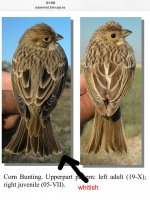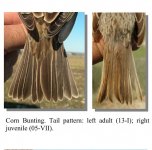Hi all,
I am far from as experienced with some of the species that have been mentioned on here so far as some of the contributors...for example, as Corn Bunting is sadly extinct in Ireland, I mainly only see this species when visiting a country within its extant range, and I have only seen a female Pine Bunting once, the co-operative bird at Wilhelminadorf, the Netherlands last winter...but I shall add my five cents worth.
Looking at the original image, which hasn't had the contrast enhanced, or colours changed all that much, and is possibly the closest fit to what the bird may have looked like in life, I would see a few problems for Pine Bunting. Namely, I would expect at least somewhat of a warmer/rusty wash underlying the streaking somewhere on the breast sides, with perhaps some of the streaks themselves being a warmer brown. Some typical birds would have quite an obvious rufous wash underlying the breast and flank feathers, and I'd just not expect such prominent and 'continuous' breast and flank streaking on a Pine Bunting. The bird also seems a bit more streaked than one would expect for a Yellowhammer, and I can't see any yellow tones to the fringes of the remiges, though I concede that erythrogenys could look greyer, as already stated by Murat.
The bill shape, despite the rather 'unfair' comparison shot showing a heavily pixellated crop of the subject bird next to a sharp image of a Corn Bunting, doesn't quite seem right for a Pine Bunting or Yellowhammer to me, but, that said, I'd much prefer to base this 'hunch' on more solid evidence.
The median coverts have obviously white or whitish tips, which is a bit worrying for Pine Bunting or Yellowhammer, but fine for Corn Bunting. Again, I concede that perhaps the poor image quality could be influencing the apparent colour, but it really does seem whitish, and there's also a faint but apparent whitish wingbar former by pale tips to the greater coverts, or seems to be anyway.
I think that the uppertail coverts that are just about visible in this image don't look rufous enough for Pine Bunting or Yellowhammer, but I could be wrong. Also, the nape is usually paler and greyer than this on a female Pine Bunting. The apparent orange tones to the leg colour do remind me of those often seen on Corn Bunting. Finally, and this is just a wild hunch based on a perhaps flawed reading of some poor images, the subject bird doesn't seem to have the typical Emberiza tertial pattern whereby the dark centres narrow abruptly towards the feather tips, producing a 'stepped' effect. Some buntings have more regular dark centres without such a step, Corn Bunting being one of them.
That said, I am more than prepared to listen to a constructive case for this being anything else. As I said, I don't see Corn Buntings very often, but that is what I think this most likely is.
Regards,
Harry










